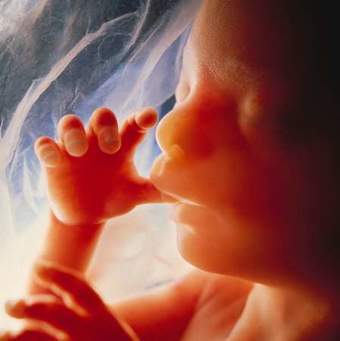Crecimiento fetal y desarrollo

Fetal Growth and Development
Introduction
There are several ways of counting the weeks in pregnancy. A common method is by gestational age. With the gestational age method, the first day of a woman’s last menstrual period begins the first day of the first week of pregnancy, even though conception has not taken place yet. This method of counting allows for differences in ovulation times. So, during approximately the first 2 weeks of gestation, a woman ovulates and conception takes place. Please keep in mind that babies grow at different rates, and that the following growth descriptions are only approximate. Your doctor will be able to provide you with information that is specific to your baby.
Week 4
By week 4, the fertilized egg, or the blastocyst, has long since traveled down the fallopian tubes and implanted in the uterus. The blastocyst cells divide into cells that will from the baby and cells that will form the placenta. The placenta nourishes a developing baby. By week 7, the embryo is approximately 5-10 mm. from crown to rump.
Week 8
By week 8, the umbilical cord forms. The umbilical cord transfers nutrients to the baby and carries waste products away. The neural tube, which will form the brain, spinal cord, and nervous system, takes shape. The heart and circulatory system form, and the embryo’s heart begins to beat at week 6. The internal organs begin to grow. The eyes and ears begin to form. The embryo develops buds where the arms and legs will grow. At week 10, the embryo is approximately 2.3 to 3.0 cm. from crown to rump and weighs from 0.3 to 0.5 ounces.
Week 12
Cartilage and bones that will be your baby’s skeleton begin to form, as well as all of the joints. Your baby will begin to move, although it is too small for you to feel it. At week 11, the baby is termed a fetus. Your baby has all of its vital organs and structures. At the end of 12 weeks, your baby is about 2 inches long and the rapid growth process begins. The baby’s head is about half of its length. The placenta starts to function to circulate blood. The genitals, fingers, toes, and hair begin to form. Amniotic fluid, which surrounds your baby, builds up.
Week 16
During this period, your baby’s face begins to develop and organs, such as the liver and pancreas start to function. It may be possible to determine the baby’s sex by looking at the genitals with ultrasound. At week 14 your baby is about 3 ½ inches long from crown to rump and weighs about 1 to 2 ounces. You may be able to hear your baby’s heart beat with a Doppler device during an examination. Your baby will start practicing to breathe and sucking his or her thumb. At the end of 16 weeks, you may just start to feel your baby move. At about week 17, your baby may be up to 7 inches from head to foot.
Week 20
During this time, your baby continues to grow rapidly and produces fat underneath the skin. Your baby begins to suck, swallow, and blink. Lanugo and vernix caseosa forms on your baby’s skin. Lanugo is soft hair that covers a fetus during pregnancy. The hair is almost all shed by the 9th month. Vernix caseosa is a white cheesy substance that covers the fetus to protect the skin while it is in the liquid environment during pregnancy.
Week 24
The heart grows stronger and the brain develops rapidly. Baby’s that are born prematurely at 23 weeks have a chance of survival. Your baby is gaining weight and by week 26 may weigh up to 2 pounds.
Week 28
The specific bones and structures in the spinal cord form. Your baby is forming hair and eyelashes. Your baby can even recognize your voice when you talk!
Week 32
Your baby’s eyes can move in the sockets. Bone marrow begins producing red blood cells. The five senses and toenails are developed. At week 35, your baby may weigh up to 5 1/2 pounds.
Week 36
Your baby continues to build fat during the last weeks of pregnancy and may gain an ounce per day. Your baby’s lungs are maturing. You may be able to see your baby practice breathing on an ultrasound. At week 36, your baby may be over 13 inches long and weigh up to 6 pounds.
Week 40
The baby positions itself head down towards the birth canal to prepare for birth. The average newborn baby weighs 7 ½ pounds and is 20 inches long.